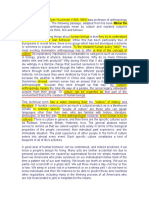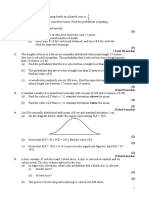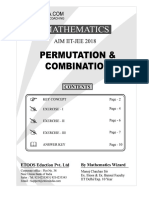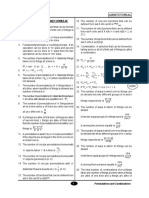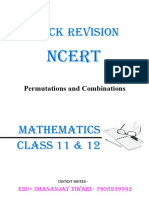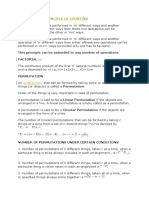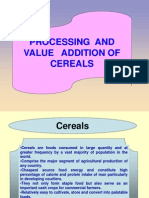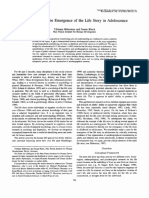Self Theory-Permutations Combinations
Uploaded by
api-294149748Self Theory-Permutations Combinations
Uploaded by
api-294149748220 Permutations and Combinations
Chapter
Permutations and Combinations
r-places :
Number of choices :
Permutations
Introduction
(1) The Factorial : Factorial notation: Let n be a
positive integer. Then, the continued product of first n
natural numbers is called factorial n, to be denoted by n !
or n .
Also, we define 0 ! = 1.
when n is negative or a fraction, n ! is not defined.
Thus, n ! = n (n 1) (n 2) ......3.2.1.
(2) Exponent of Prime p in n ! : Let p be a
prime number and n be a positive integer. Then the last
integer amongst 1, 2, 3, .......(n 1), n which is divisible
n
n
by p is
p , where
denotes the greatest
p
p
n
integer less than or equal to
.
p
The ways of arranging or selecting a smaller or an
equal number of persons or objects at a time from a
given group of persons or objects with due regard being
paid to the order of arrangement or selection are called
the (different) permutations.
For example : Three different things a, b and c are
given, then different arrangements which can be made
by taking two things from three given things are ab, ac,
bc, ba, ca, cb.
Therefore the number of permutations will be 6.
Number of permutations without repetition
(1) Arranging n objects, taken r at a time
equivalent to filling r places from n things.
2
n(n 1)(n 2).....(n r 1)((n r)!)
n!
n Pr
(n r)!
(n r)!
(2) The number of arrangements of n different
objects taken all at a time =
(i)
P0
Pn n!
n!
1; n Pr n.n1 Pr 1
n!
(ii) 0! 1;
1
0 or (r)! (r N )
(r)!
Number of permutations with repetition
Definition of permutation
The number of ways of arranging = The number of
ways of filling r places.
n(n 1)(n 2).......(
n r 1)
=
=
n (n 1) (n 2) (n 3)
r
n (r 1)
(1) The number of permutations (arrangements) of
n different objects, taken r at a time, when each object
may occur once, twice, thrice,........upto r times in any
arrangement = The number of ways of filling r places
where each place can be filled by any one of n objects.
r
4
2
1
3
r places :
Number of choices : n
n
n
n
n
The number of permutations = The number of
ways of filling r places = (n)r .
(2) The number of arrangements that can be
formed using n objects out of which p are identical (and
of one kind) q are identical (and of another kind), r are
identical (and of another kind) and the rest are distinct
n!
is
.
p!q!r!
221 Permutations and Combinations
Conditional permutations
(1) Number of permutations of n dissimilar things
taken r at a time when p particular things always occur
=
n p
Cr p r! .
(2) Number of permutations of n dissimilar things
taken r at a time when p particular things never occur =
n p
C r r! .
anticlockwise orders are taken as different is
may be repeated any number of times, is
n(n 1)
.
n1
(4) Number of permutations of n different things,
taken all at a time, when m specified things always
come together is m! (n m 1)! .
(5) Number of permutations of n different things,
taken all at a time, when m specified things never come
together is n!m! (n m 1)! .
(6) Let there be n objects, of which m objects are
alike of one kind, and the remaining (n m) objects are
alike of another kind. Then, the total number of mutually
distinguishable permutations that can be formed from
n!
these objects is
.
(m!) (n m)!
The above theorem can be extended further i.e., if
there are n objects, of which p1 are alike of one kind;
p2 are alike of another kind; p3 are alike of 3rd
kind;......; pr
are alike of rth kind such that
p1 p2 ...... pr n ;
then
the
number
of
of
these
objects
is
n!
.
(p1 !) (p2 !) ...... (pr !)
Circular permutations
In circular permutations, what really matters is the
position of an object relative to the others.
Thus, in circular permutations, we fix the position of
the one of the objects and then arrange the other objects
in all possible ways.
There are two types of circular permutations :
(i) The circular permutations in which clockwise
and the anticlockwise arrangements give rise to
different permutations, e.g. Seating arrangements of
persons round a table.
(ii) The circular permutations in which clockwise
and the anticlockwise arrangements give rise to same
permutations, e.g. arranging some beads to form a
necklace.
Difference between clockwise and anticlockwise arrangement : If anti-clockwise and
clockwise order of arrangement are not distinct e.g.,
arrangement of beads in a necklace, arrangement of
flowers in garland etc. then the number of circular
permutations of n distinct items is
(n 1)!
.
2
Pr
.
r
(ii) Number of circular permutations of n different
things, taken r at a time, when clockwise and
n
anticlockwise orders are not different is
(3) The total number of permutations of n different
things taken not more than r at a time, when each thing
permutations
(i) Number of circular permutations of n different
things, taken r at a time, when clockwise and
Pr
.
2r
Theorems on circular permutations
Theorem (i) : The number of circular
permutations of n different objects is (n 1)! .
Theorem (ii) : The number of ways in which n
persons can be seated round a table is (n 1)!.
Theorem (iii) : The number of ways in which n
different beads can be arranged to form a necklace, is
1
(n 1)!.
2
Combinations
Definition
Each of the different groups or selections which
can be formed by taking some or all of a number of
objects, irrespective of their arrangements, is called a
combination.
Notation : The number of all combinations of n
things, taken r at a time is denoted by C (n, r) or
n
n
C r or .
r
n
Cr is always a natural number.
Difference between a permutation and
combination :
(i) In a combination only selection is made whereas
in a permutation not only a selection is made but also
an arrangement in a definite order is considered.
(ii) Each combination corresponds to many
permutations. For example, the six permutations ABC,
ACB, BCA, BAC, CBA and CAB correspond to the same
combination ABC.
Number of combinations without repetition
The number of combinations (selections or groups)
that can be formed from n different objects taken
r(0 r n) at a time is
n
Cr
n!
. Also
r !(n r)!
Cr nCn r .
Let the total number of selections (or groups) = x.
Each group contains r objects, which can be arranged in
r ! ways. Hence the number of arrangements of r
objects = x (r!) . But the number of arrangements
=
Pr .
Permutations and Combinations
x(r!) nPr x
Pr
n!
x
nCr
r!
r !(n r)!
Number of combinations with repetition and all
possible selections
(1) The number of combinations of n distinct
objects taken r at a time when any object may be
repeated any number of times.
= Coefficient of xr in (1 x x 2 ....... xr )n
= Coefficient of xr in (1 x) n n r 1C r
C1 nC2 ........ nCn 2n 1 .
(3) The total number of ways in which it is possible
make groups by taking some or all out of
n (n1 n2 ....) things, when n1 are alike of one
to
n2 are alike of second kind, and so on is
{(n1 1)(n2 1)......} 1 .
kind,
(4) The number of selections of r objects out of n
identical objects is 1.
(5) Total number of selections of zero or more
objects from n identical objects is n 1 .
(6) The number of selections taking at least one
out of a1 a2 a3 ...... an + k objects, where a1
are alike (of one kind),
a2 are alike (of second kind)
and so on...... an are alike (of nth kind) and k are distinct
= [(a1 1)(a2 1)(a3 1).......(
an 1)]2k 1
.
Conditional combinations
(1) The number of ways in which r objects can be
selected from n different objects if k particular objects
are
(i) Always included =
included =
nk
nk
C r k
(ii)
Never
Cr
Cr
r p and
n p
if
r p.
n p
C r 1
n p
C r 2 .......
n p
C 0 , if
C r n p C r 1 n p C r 2 ....... n p C r p ,
Case I : (1) The number of ways in which n
different things can be arranged into r different groups
n r 1
or Coefficient of xn is n ! (e x 1)r .
Here blank groups are not allowed.
(3) Number of ways in which m n different
objects can be distributed equally among n persons (or
numbered groups) = (number of ways of dividing into
groups)
(number
of
groups)
!
=
(mn)!n!
n
(m!) n!
(mn)!
(m!)n
Case II : (1) The number of ways in which
which
contain
and
things
(m n)!
m n
C m.n C n
,m n .
m!n!
Pn or n !
n1
respectively
is,
Corollary: If m n , then the groups are equal
size. Division of these groups can be given by two
types.
Type I : If order of group is not important :
The number of ways in which 2n different things can be
divided equally into two groups is
(2n)!
2!(n!)2
Type II : If order of group is important : The
number of ways in which 2n different things can be
divided
equally
into
two
distinct
groups
is
(2n)!
2
2!(n!)
2!
2n!
(n!)2
(2) The number of ways in which (m + n + p)
different things can be divided into three groups which
contain m, n and p things respectively is
m n p
C m.n pCn . p C p
(m n p)!
,m n p .
m!n! p!
Corollary : If m n p , then the groups are
equal size. Division of these groups can be given by two
types.
Type I : If order of group is not important :
The number of ways in which 3p different things can be
(3p)!
3!(p!)3
Type II : If order of group is important : The
number of ways in which 3p different things can be
divided equally into three distinct groups is
(3p)!
(3p)!
3!
.
3
3!(p!)
(p!)3
(i) If order of group is not important : The number
of ways in which mn different things can be divided
Division into groups
is
divided equally into three groups is
(2) The number of combinations of n objects, of
which p are identical, taken r at a time is
n p
(m n) different things can be divided into two groups
(2) The total number of ways in which it is possible
to form groups by taking some or all of n things at a
time is
222
r C1 (r 1) C 2 (r 2) ......... (1)n1 nC r 1
n
C r 1 according as blank group
are or are not admissible.
(2) The number of ways in which n different things
can be distributed into r different group is
equally into m groups is
mn!
(n!)m m!
(ii) If order of group is important: The number of
ways in which mn different things can be divided
223 Permutations and Combinations
equally
into
(mn)!
(n!)m m!
(mn)!
m!
(n!)m
distinct
groups
is
of solutions to the equation x1 x2 ...... xm n
(i)
Subject to the condition
Derangement
Any change in the given order of the things is
called a derangement.
If n things form an arrangement in a row, the
number of ways in which they can be deranged so that
no one of them occupies its original place is
1
1
1
1
.
n! 1
...... (1)n .
1
!
2
!
3
!
n
!
Some important results for geometrical problems
(1) Number of total different straight lines formed
by joining the n points on a plane of which m (< n) are
collinear is
C2 m C2 1 .
(2) Number of total triangles formed by joining the
n points on a plane of which m (< n) are collinear is
n
Let x1, x2 ,.......,xm be integers. Then number
C 3 mC 3 .
a1 x1 b1, a2 x2 b2 ,.......,am xm bm .....
(ii)
is equal to the coefficient of x n in
(x a1 x a1 1 ...... xb1 )(x a2 x a2 1 ..... xb2 )......(xam xam
.....(iii)
This is because the number of ways, in which sum
of m integers in (i) equals n, is the same as the number
of times x n comes in (iii).
(1) Use of solution of linear equation and
coefficient of a power in expansions to find the
number of ways of distribution : (i) The number of
integral solutions of x1 x2 x3 ...... xr n where
x1 0, x2 0,......xr 0 is the same as the number
of ways to distribute n identical things among r persons.
(3) Number of diagonals in a polygon of n sides is
n
C2 n .
(4) If m parallel lines in a plane are intersected by
a family of other n parallel lines. Then total number of
parallelograms
so
formed
is
m
C 2 nC 2 i.e.,
(ii) Number of triangles =
1 rx
C4 .
and number of squares of any size is
xn in
r(r 1) 2
r(r 1)(r 2)....(r n 1)
x ....
x
2!
n!
r(r 1)(r 2)....(r n 1) (r n 1)! nr 1
Cr
n!
n!(r 1)!
.
(2)
The
x1 x2 x3
number
of
(8) In a rectangle of n p (n p) number of
of
number
of
integral
solutions
..... xr n
of
where
x1 1, x2 1,.......xr 1 is same as the number of
ways to distribute n identical things among r persons
each getting at least 1. This also equal to the coefficient
r 1
rectangles
of xn in the expansion of (x1 x 2 x 3 ......)r .
= coefficient of
C2
r 1
= coefficient of xn in (1 x) r
(6) If n straight lines are drawn in the plane such
that no two lines are parallel and no three lines are
concurrent. Then the number of part into which these
lines divide the plane is = 1 n .
(7) Number of rectangles of any size in a square of
= coefficient of xn in
C3
(iii) Number of quadrilaterals =
is
expansion of (x 0 x1 x 2 x 3 ......)r
points on the circumference of a
(i) Number of straight lines =
This is also equal to the coefficient of xn in the
mn(m 1)(n 1)
.
4
(5) Given n
circle, then
n n
.....
any
size
squares
is
np
(n 1)(p 1)
4
of
any
size
and
is
= coefficient of xn in
= coefficient of xn in x r (1 x) r
= coefficient of xn in
(n 1 r)(p 1 r) .
r 1
Multinomial theorem
r (r 1) 2
r (r 1)(r 2)...(r n 1)
xr 1 rx
x ...
x
2!
n!
= coefficient of xnr in
Permutations and Combinations
n
224
C x Cy x y or x y n .
r(r 1) 2
r(r 1)(r 2)....(r n 1) n
n
x ...
x .....
1 rx
n1C
n
.
r 1 (n r 1) Cr 1 .
2!
n!
r(r 1)(r 2)......(r n r 1)
(n r)!
r(r 1)(r 2).....(n 1)
(n r)!
are
different
where
primes
and
1 , 2 , 3 ,......, k are natural numbers then :
(1) The total number of divisors of N including 1
k 1) .
and N is = ( 1 1)( 2 1)( 3 1)....(
(2) The total number of divisors of N excluding 1
k 1) 2 .
and N is = ( 1 1)( 2 1)( 3 1).....(
(3) The total number of divisors of N excluding 1 or
k 1) 1 .
N is = ( 1 1)( 2 1)( 3 1).....(
C n1 or
of
n
p12
......
p11 )(p20
p12
Cr
Cr is
C n1 .
2
n n1
. Cr 1 .
r
Number of selections of zero or more things out
n
different
things
is,
The number of ways of answering one or more
questions when each question has an alternative is,
3n 1 .
The number of ways of answering all of n
questions when each question has an alternative is
2n .
C0 nC2 n C4 ...... nC1 nC3 nC5 ..... 2n1
.
p11
Cr is
C0 nC1 nC2 ..... nCn 2n .
(4) The sum of these divisors is
(p10
If n is odd then the greatest value of
p11 .p22 .p33 ......pk k ,
p1, p2 , p3 ,......pk
Cn / 2 .
Number of divisors
Let
(n 1)!
n1C r 1 .
(n r)!(r 1)!
If n is even then the greatest value of
p22
...
p2 2 ).....
(pk0 pk1 pk2 .... pk k )
(5) The number of ways in which N can be
resolved as a product of two factors is
2n1
C0 2n1C1 2n1C2 ..... 2n1Cn 22n .
Cn n1Cn n 2Cn n 3Cn .... 2n1Cn 2nCn1
Number of combinations of n dissimilar things
n
n!
Cn
1,
taken all at a time
1
n !(n n)! 0 !
2 ( 1 1)( 2 1)....( k 1),If N is nota perfectsquare
(0 ! 1) .
1
[( 1 1)( 2 1).....( k 1) 1],If N is a perfect
square
Gap method : Suppose 5 males A, B, C, D, E are
2
(6) The number of ways in which a composite
number N can be resolved into two factors which are
relatively prime (or co-prime) to each other is equal to
2n1 where n is the number of different factors in N.
arranged in a row as A B C D E . There
will be six gaps between these five. Four in between
and two at either end. Now if three females P, Q,R are
to be arranged so that no two are together we shall
use gap method i.e., arrange them in between these
6 gaps. Hence the answer will be
C0 nCn 1, nC1 n .
Cr nCr 1 n1Cr .
P3 .
Together : Suppose we have to arrange 5
persons in a row which can be done in 5 ! = 120
ways. But if two particular persons are to be together
always, then we tie these two particular persons with
a string. Thus we have 5 2 + 1 (1 corresponding to
these two together) = 3 +1 = 4 units, which can be
arranged in 4! ways. Now we loosen the string and
these two particular can be arranged in 2! ways. Thus
225 Permutations and Combinations
Definition of permutation, Number of permutations
with or without repetition, Conditional permutations
total arrangements = 24 2 = 48.
Never together = Total Together = 120 48 = 72.
The number of ways in which n (one type of
different) things and n (another type of different)
things can be arranged in a row alternatively is
1.
2.n!.n! .
The number of ways in which m things of one
type and n things of another type can be arranged in
the form of a garland so that all the second type of
things come together
2.
m!n!
and no two things of
2
second type come together
(m 1)! mPn
.
2
3.
All those numbers, which have either 0 or 5 as
the last digit, are divisible by 5.
All those numbers sum of whose digit is divisible
by 9 are divisible by 9.
4.
given
different
digits
(a,
5.
(n 1)!(a1 a2 a3 ...... an) . Sum of the total
(n 1)!(a1 a2 a3 ...... an) .
(1111......... n times).
P2
(d)
P3
(b)
C4
(c) 64
(d) None of these
How many numbers can be formed from the digits
1, 2, 3, 4 when the repetition is not allowed
(a)
P4
(c)
P1 4 P2 4 P3
4
(b)
P3
(d)
P1 P2 P3 P4
There are 3 candidates for a post and one is to be
selected by the votes of 7 men. The number of
ways in which votes can be given is
7
(c)
C3
(b) 37
(d) None of these
6.
4 buses runs between Bhopal and Gwalior. If a
man goes from Gwalior to Bhopal by a bus and
comes back to Gwalior by another bus, then the
total possible ways are
(a) 12
(b) 16
(c) 4
(d) 8
7.
If
8.
numbers in this case can be obtained by applying the
formula
(a) 73
a2, a3..........
an ) then sum of the digits in the unit
place of all numbers formed without repetition is
(b)
The number of ways in which 6 rings can be worn
on the four fingers of one hand is
All those numbers whose last two digits are
divisible by 25 are divisible by 25 e.g., 73125, 2400
etc.
are
P2
(a) 4
All those numbers, which are divisible by 2 and 3
simultaneously, are divisible by 6. e.g., 108, 756 etc.
All those numbers whose last three-digit number
is divisible by 8 are divisible by 8.
P2
[AMU 1983]
All those numbers whose last two-digit number is
divisible by 4 are divisible by 4 e.g., 7312, 8936, are
such that 12, 36 are divisible by 4 and hence the given
numbers are also divisible by 4.
we
(c)
All the numbers sum of whose digits are divisible
by 3,is divisible by 3 e.g., 534. Sum of the digits is
12, which are divisible by 3, and hence 534 is also
divisible by 3.
If
(a)
All the numbers whose last digit is an even
number 0, 2, 4, 6 or 8 are divisible by 2.
If the best and the worst paper never appear
together, then six examination papers can be
arranged in how many ways
(a) 120
(b) 480
(c) 240
(d) None of these
How many numbers divisible by 5 and lying
between 3000 and 4000 can be formed from the
digits 1, 2, 3, 4, 5, 6 (repetition is not allowed)
9.
P5 20. nP3 , then
(a) 4
(b) 8
(c) 6
(d) 7
How many words comprising of any three letters
of the word UNIVERSAL can be formed
(a) 504
(b) 405
(c) 540
(d) 450
If
P4 : nP5 1 : 2 , then
[MP PET 1987;
RPET 1996]
10.
(a) 4
(c) 6
(b) 5
(d) 7
In how many ways can
n letter-boxes
mn
(a) (mn)n
(b) mmn
letters be posted in
Permutations and Combinations
mn
(c) n
(d) None of these
226
You might also like
- Chapter 4 - Fundamental Principles of CountingNo ratings yetChapter 4 - Fundamental Principles of Counting4 pages
- Permutation & Combination: Fundamental Principle of CountingNo ratings yetPermutation & Combination: Fundamental Principle of Counting6 pages
- Places: No. of Choices: 1 2 3 4 5: Example: 1No ratings yetPlaces: No. of Choices: 1 2 3 4 5: Example: 117 pages
- Probability Permutations and CombinationsNo ratings yetProbability Permutations and Combinations3 pages
- Learning Module - Statistics and ProbabilityNo ratings yetLearning Module - Statistics and Probability123 pages
- Fiitjee Polynomials Rmo, Nsejs Theory+QuestionsNo ratings yetFiitjee Polynomials Rmo, Nsejs Theory+Questions20 pages
- Tuesday (2:30-4:30) Wednesday (7:30-9:30) Tuesday (2:30-4:30)No ratings yetTuesday (2:30-4:30) Wednesday (7:30-9:30) Tuesday (2:30-4:30)3 pages
- Permutation: Thomas F. Valencia ReporterNo ratings yetPermutation: Thomas F. Valencia Reporter15 pages
- Mathematical Reasoning Notes For JEE Main - pdf-36No ratings yetMathematical Reasoning Notes For JEE Main - pdf-364 pages
- Permutation & Combination: Type (I) : Very Short Answer Type Questions: (01 Mark Each) 1. 2. 3. 4No ratings yetPermutation & Combination: Type (I) : Very Short Answer Type Questions: (01 Mark Each) 1. 2. 3. 423 pages
- Illustration:: Fundamental Rules of CountingNo ratings yetIllustration:: Fundamental Rules of Counting8 pages
- Class X S.A. II Maths Chapter Wise 5 Printable Worksheets With SolutionNo ratings yetClass X S.A. II Maths Chapter Wise 5 Printable Worksheets With Solution253 pages
- Pre-Calculus Math 40s - Permutations & Combinations - Lesson 1No ratings yetPre-Calculus Math 40s - Permutations & Combinations - Lesson 10 pages
- 348 - 61275 - BA124 - 2018 - 4 - 2 - 1 - Solution Assignment 1-2 - Math2100% (1)348 - 61275 - BA124 - 2018 - 4 - 2 - 1 - Solution Assignment 1-2 - Math213 pages
- Book 32 - Sequence and Series - Class 11No ratings yetBook 32 - Sequence and Series - Class 1135 pages
- Inverse Trigonometric Functions (Trigonometry) Mathematics Question BankFrom EverandInverse Trigonometric Functions (Trigonometry) Mathematics Question BankNo ratings yet
- 12 Mathematics Permutations CombinationsNo ratings yet12 Mathematics Permutations Combinations16 pages
- 2022-03-Systematic Observation (Update 2022 09)No ratings yet2022-03-Systematic Observation (Update 2022 09)67 pages
- NV Strip Type Fuse-Switch-Disconnector Sizes 00, 1, 2, 3No ratings yetNV Strip Type Fuse-Switch-Disconnector Sizes 00, 1, 2, 33 pages
- Bagarea in Seama Si Futerea de Mama. Un Studiu Extins de Andu BanduNo ratings yetBagarea in Seama Si Futerea de Mama. Un Studiu Extins de Andu Bandu1 page
- Nature Environment and Pollution TechnologyNo ratings yetNature Environment and Pollution Technology7 pages
- PH 474A-K - Synthetic Gear Oil - Extreme Pressure (EP)No ratings yetPH 474A-K - Synthetic Gear Oil - Extreme Pressure (EP)4 pages
- Contractor Daily Activity Pre-Inspection 50-Items Safety ChecklistNo ratings yetContractor Daily Activity Pre-Inspection 50-Items Safety Checklist1 page
- Getting A Life: The Emergence of The Life Story in AdolescenceNo ratings yetGetting A Life: The Emergence of The Life Story in Adolescence22 pages
- Coefficients For Cement Consumption in QuintalNo ratings yetCoefficients For Cement Consumption in Quintal14 pages
- Download Complete VLSI Physical Design From Graph Partitioning to Timing Closure 2nd Edition Andrew B. Kahng PDF for All Chapters100% (1)Download Complete VLSI Physical Design From Graph Partitioning to Timing Closure 2nd Edition Andrew B. Kahng PDF for All Chapters65 pages
- Full Download Serious Cycling 2nd Edition Edmund R. Burke PDF DOCX100% (15)Full Download Serious Cycling 2nd Edition Edmund R. Burke PDF DOCX60 pages
- Cambridge First (FCE) Reading Part 1: Answer All The Questions and Check Your Answers at The EndNo ratings yetCambridge First (FCE) Reading Part 1: Answer All The Questions and Check Your Answers at The End45 pages
- Permutation & Combination: Fundamental Principle of CountingPermutation & Combination: Fundamental Principle of Counting
- Tuesday (2:30-4:30) Wednesday (7:30-9:30) Tuesday (2:30-4:30)Tuesday (2:30-4:30) Wednesday (7:30-9:30) Tuesday (2:30-4:30)
- Mathematical Reasoning Notes For JEE Main - pdf-36Mathematical Reasoning Notes For JEE Main - pdf-36
- Permutation & Combination: Type (I) : Very Short Answer Type Questions: (01 Mark Each) 1. 2. 3. 4Permutation & Combination: Type (I) : Very Short Answer Type Questions: (01 Mark Each) 1. 2. 3. 4
- Class X S.A. II Maths Chapter Wise 5 Printable Worksheets With SolutionClass X S.A. II Maths Chapter Wise 5 Printable Worksheets With Solution
- Pre-Calculus Math 40s - Permutations & Combinations - Lesson 1Pre-Calculus Math 40s - Permutations & Combinations - Lesson 1
- 348 - 61275 - BA124 - 2018 - 4 - 2 - 1 - Solution Assignment 1-2 - Math2348 - 61275 - BA124 - 2018 - 4 - 2 - 1 - Solution Assignment 1-2 - Math2
- Inverse Trigonometric Functions (Trigonometry) Mathematics Question BankFrom EverandInverse Trigonometric Functions (Trigonometry) Mathematics Question Bank
- NV Strip Type Fuse-Switch-Disconnector Sizes 00, 1, 2, 3NV Strip Type Fuse-Switch-Disconnector Sizes 00, 1, 2, 3
- Bagarea in Seama Si Futerea de Mama. Un Studiu Extins de Andu BanduBagarea in Seama Si Futerea de Mama. Un Studiu Extins de Andu Bandu
- PH 474A-K - Synthetic Gear Oil - Extreme Pressure (EP)PH 474A-K - Synthetic Gear Oil - Extreme Pressure (EP)
- Contractor Daily Activity Pre-Inspection 50-Items Safety ChecklistContractor Daily Activity Pre-Inspection 50-Items Safety Checklist
- Getting A Life: The Emergence of The Life Story in AdolescenceGetting A Life: The Emergence of The Life Story in Adolescence
- Download Complete VLSI Physical Design From Graph Partitioning to Timing Closure 2nd Edition Andrew B. Kahng PDF for All ChaptersDownload Complete VLSI Physical Design From Graph Partitioning to Timing Closure 2nd Edition Andrew B. Kahng PDF for All Chapters
- Full Download Serious Cycling 2nd Edition Edmund R. Burke PDF DOCXFull Download Serious Cycling 2nd Edition Edmund R. Burke PDF DOCX
- Cambridge First (FCE) Reading Part 1: Answer All The Questions and Check Your Answers at The EndCambridge First (FCE) Reading Part 1: Answer All The Questions and Check Your Answers at The End

